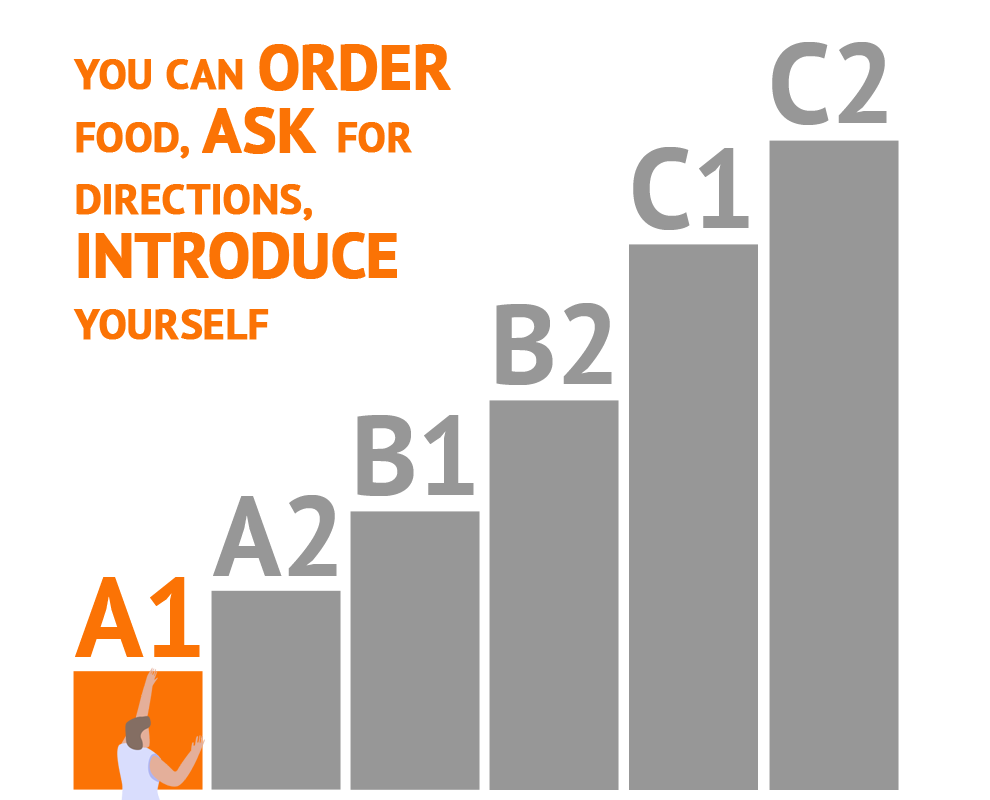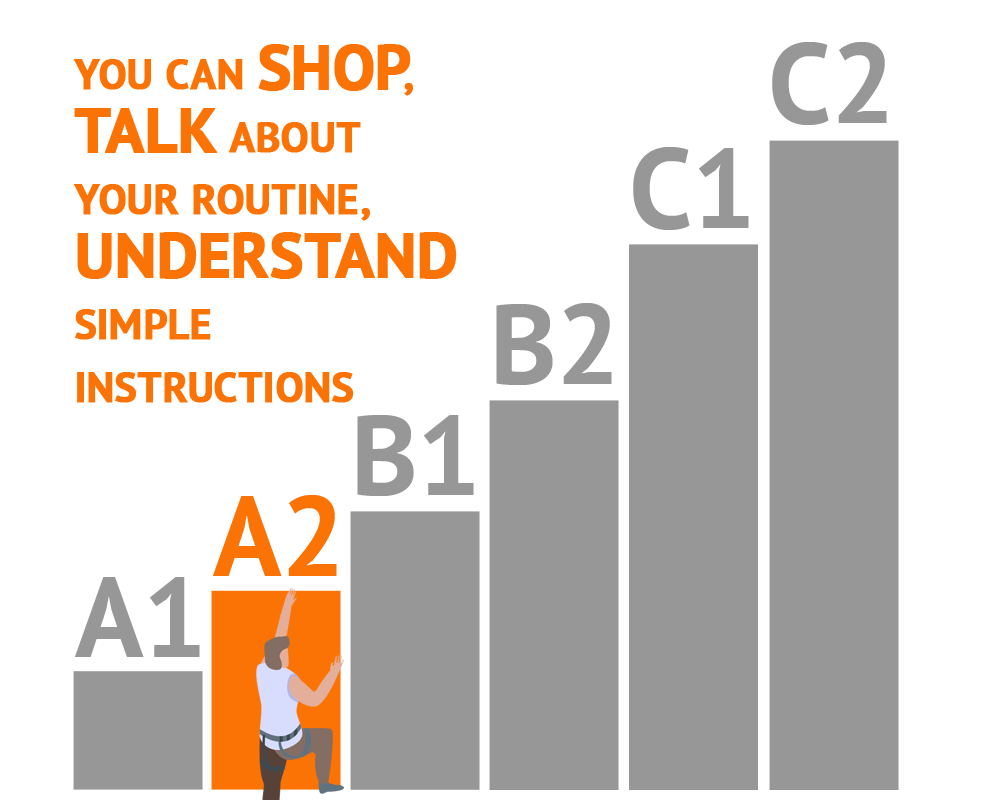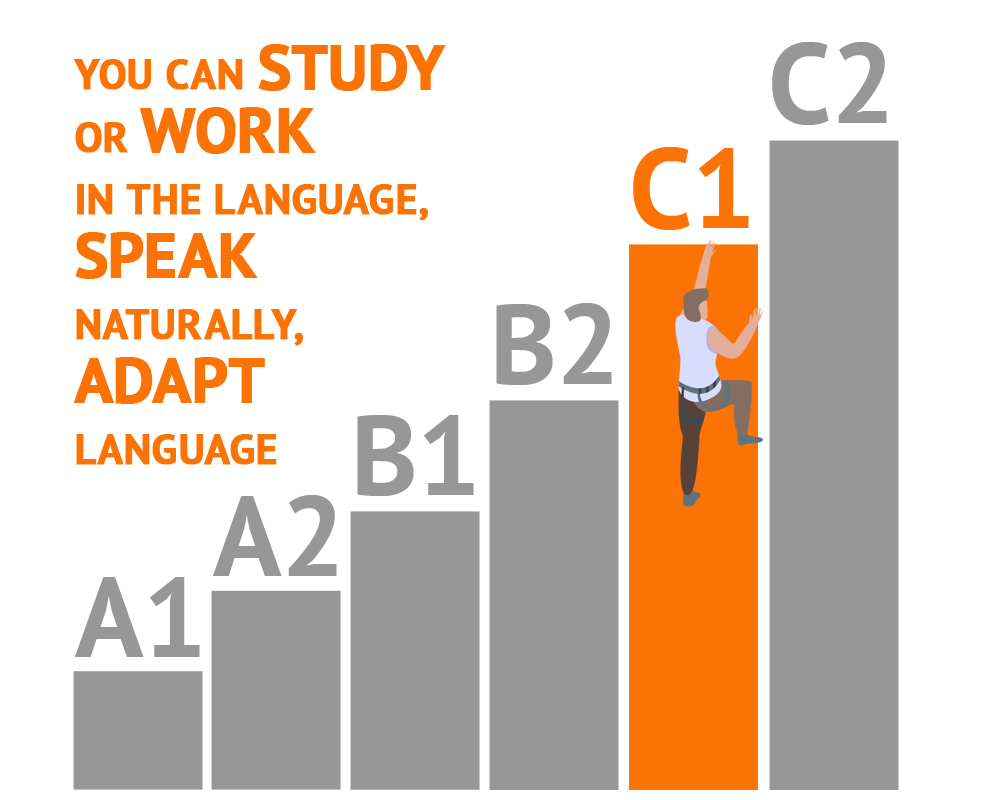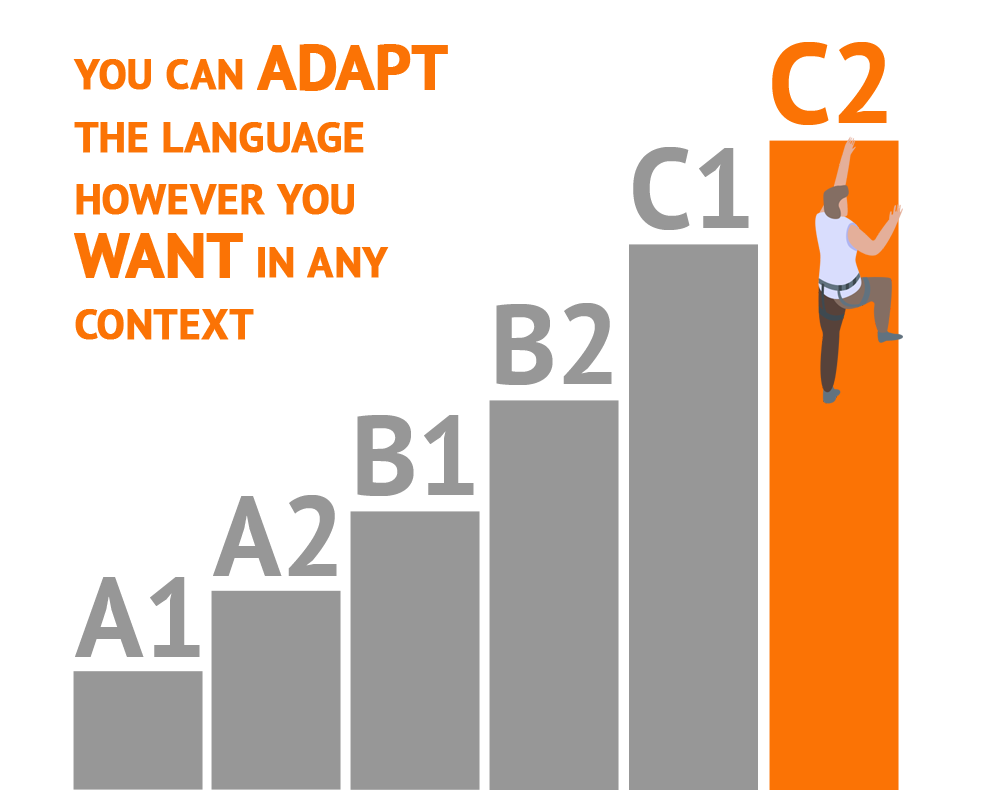CEFR Language Levels A1-C2: Complete Skills Description
How to Check Your English Level
What is the CEFR?
The CEFR is a system that tells you your proficiency level in any given language. There are six CEFR language levels: A1, A2, B1, B2, C1, and C2, where A1 indicates beginners, and C2 describes proficiency. CEFR stands for Common European Framework of Reference for Languages, and the system is used worldwide.
You can determine your CEFR language proficiency level by what you "can do" in the language. That is, the kind of phrases you can understand, speak, read, write, and so on.
All CEFR levels are explained in this guide with examples so you can determine your proficiency.
Purpose and Use of the CEFR
The purpose of the CEFR language proficiency levels is to give learners, teachers, and institutions a framework to measure one's language skills to know how to communicate effectively with them.
For example:
- Textbooks are written for younger classes using a lower CERF proficiency level that the students can understand. Whereas textbooks for advanced classes use higher language levels.
- If you want to study abroad, the school asks for your CEFR level to know if you can follow lessons in that country's language.
- Employers may ask for your CEFR level to know if you can handle everyday customer interactions and workplace communication.
- Language schools use this system to place you in the right class so you can learn alongside people at your level.
Take a quick test to know your CERF level now
Who Created the CEFR and Why?
The CEFR was created by the Council of Europe. The goal was to make language learning more consolidated and consistent globally.
Before the CEFR, every country had different ways to measure language ability. Such inconsistency made it hard for one to know their actual ability when crossing borders.
Now, let's discuss the CEFR language proficiency levels so you know where you stand.
CEFR Level A1
CEFR level A1 is the starting point of the CEFR language levels. At A1, you’re just starting with the language. You can say hello, tell people your name, ask simple questions like “Where are you from?” or “What’s this?” A1 is the level where you learn enough words and phrases to survive basic everyday situations.

Vocabulary
At language level A1, your vocabulary is very basic, involving simple words for everyday needs. You can recognise words for food, family, colours, etc. In this level, you can manage a short list of words but not long descriptions.
Grammar
Grammar at level A1 is simple. You know simple phrases like "I live...", "I am...", "I need..." "Where is the...?" Basically simple present tenses. You can also use short answers like "Yes" or "I don't know."
Speaking
For the A1 CEFR language level, you can say short sentences, introduce yourself, and ask simple questions. "My name is Fred, "What is your name?" But your speech is slow and you'd often need assistance from the other person.
Listening
You can only understand simple and short sentences if the person speaks slowly. You can follow simple instructions like "Come here" or "Turn right." You can also understand when prices, names, and simple everyday words are spoken clearly.
Reading
At CERF level A1, you can only read short texts, mostly predictable ones. For example, you can read "open", "exit", "one ticket", "Room for two people." Sometimes, the context of a long sentence can help you guess the meaning even when you don't know every word.
Writing
At A1 CERF language level, you can fill out forms about your identity. You can write simple sentence like "I am at home," "I am 25 years old." At this level, your sentences are short, and you may not always spell correctly, but the reader can understand.
Real-Life Examples for A1 Learners
- Ordering a snack using a short sentence like “I want a burger.”
- Asking a simple question like “Where is the bus stop?” and understanding a short answer.
- Telling someone your name and where you live
- Writing a short message to a friend, such as “I arrive at 6.”
To sum up, CEFR AI is beginner-level for language learners. At this level, you are able to understand and use basic phrases that help you survive in the environment. But you're still not very familiar with the past tense.
CEFR Level A2
A2 is the second level of the CEFR. At this level, you can handle simple everyday expressions and conversations. Not just basic survival language anymore, but longer interactions. The CEFR A2 language level is important as it shows you can deal with familiar situations at home, work, or when travelling.

Vocabulary
At A2, you can deal with more of your daily life in the language. You can order food, talk a little about your family or your job, and ask for information when you travel. You know enough words to describe people around you, like “My neighbour is tall and very friendly,” or “My office is small but busy.”
Grammar
Your grammar in A2 is more flexible than in A1. You can use present tense confidently, past tense mildly, and conjunctions like "because," "but", and "so". You are able to connect ideas and express thoughts more clearly, but you may still make grammatical mistakes.
Speaking
You can hold small conversations, explain what you like, and describe familiar things in simple words. For example, you can explain what you want to do or describe your weekend. However, people in A2 cannot yet use big words and phrases.
Listening
At CEFR language level A2, you can usually follow clear, not-too-fast speech about familiar things like work, family or free time. You can catch details when someone talks about their day or their plans. But if people speak very quickly or use a lot of unusual words, you’ll probably get lost.
Reading
At A2 language proficiency level, you can read short texts such as messages from friends, simple stories, signs, and basic instructions. You can understand things like “The train leaves 30 minutes after check-in,” especially when the topic is familiar.
Writing
In this level, you can convey your thoughts more clearly in writing using simple words. For example, you can write out messages like "I cannot go to work because I am feeling sick." Yes, there will be mistakes, but your meaning is clear.
Real-Life Examples for A2 Learners
- Explaining the kind of product you want. Example: “Hello. I want a small backpack. Do you have one for school or work?”
- Telling a friend about your weekend using a few connected sentences: “On Saturday I went to the park. I walked and took some photos.”
- Understanding simple instructions from a doctor, teacher, or colleague.
In summary, A2 language proficiency level shows you can now engage in everyday interactions. You understand and can describe things.
CEFR Level B1
CEFR level B1 is considered the intermediate proficiency level. At this stage, you move from basic communication to more independent use of the language. This point in the CEFR scale is important as it allows you to engage in longer conversations and social settings confidently.

Vocabulary
Your vocabulary in the CEFR level B1 is wide enough to handle most topics about work, study, health, news, and lifestyle. You can give names to emotions like feeling "worried", "anxious", etc. You know abstracts like "decision" and "reason".
Grammar
People in CERF B1 level can understand and use more complex sentences. At this proficiency level in the CEFR scale, you can use connectors, past and future tense quite well: "It might rain later in the evening, although it is sunny now." "He packed the luggage. However, he left this one out." Modal verbs like "Should," "might", "must", begin to feel more natural.
Speaking
At this proficiency level, you no longer need to rely on memorised phrases. Words come naturally to you, and you can engage in long conversations on familiar topics. You can explain events in detail, although sometimes with grammatical mistakes here and there.
Listening
When you are at B1 proficiency level, listening is easier as you can understand complex sentences. You can follow the news, a radio broadcast, and grasp the points of a meeting, provided the speech is clear. Fast speech still proves difficult.
Reading
At B1, you can read news reports, articles, and stories without much fuss, as long as it's a familiar topic. For unfamiliar topics, you may get the general idea from the words you do know.
Writing
You can write paragraphs, simple essays, and messages about events in detail. You can share opinions and ideas clearly without always searching for the right words.
Real-Life Examples for B1 Learners
- Explaining a problem in a shop or workplace and asking for a solution.
- Describing what happened at school or work.
- Understanding a news report about a familiar topic.
In summary, B1 proficiency level is the CERF language level where you begin to speak and express ideas with more ease.
CEFR Level B2
CERF Level B2 is an important point on the CERF scale as you can now use the language more confidently and flexibly. You understand some complex words and can use them, sometimes drawing meanings from context. B2 is also regarded as the upper intermediate level. At B2, you can interact in social and professional settings fluently.

Vocabulary
You can handle most academic and workplace vocabulary at this level. You can use expressions like “experience” "challenge" and "affordable". At B2, phrasal verbs (e.g. break down, give up) and common idiomatic expressions feel natural to you.
Grammar
Your grammar at B2 allows you to express complex ideas perfectly. You can use conditionals (e.g would, could), past perfect tenses, and reported speech. If you comfortably say things like, "He said he would take the job if it pays well," you are already at the B2 CERF language proficiency level. You can also use linkers like "on the other hand..."
Speaking
You can hold long conversations, argue fluently, and express opinions naturally. At B2 level, words come naturally to you. Less effort in stringing the right terms together. However, some nuanced expressions may still prove difficult.
Listening
At B2 CERF level, you can understand TV shows and discussions even when people speak quickly. You can catch many details and instructions. You can follow information about policies in the news. Very fast, informal or colloquial speech may still be hard to follow.
Reading
Reading is easy at B2. You can read long texts and understand easily. For example, you can read a news report about some global event or a product. You run into unknown words now and then, but you can often figure out the meaning from the context.
Writing
Writing at the B2 CEFR level is clear, structured, and engaging, as you can use both simple and complex sentences to express your ideas. You can describe problems and solutions clearly. Even though you still make minor errors, people understand you easily.
Real-Life Examples for B2 Learners
- Discussing a project at a meeting.
- Writing a long essay about a problem and solutions
- Reading a long report or academic textbook with a clear understanding.
Generally, B2 is the upper intermediate level on the CERF scale—at this level, you are considered fluent. You can read, write, speak, and understand even complex ideas.
CEFR Level C1
CEFR Level C1 is an advanced point on the CEFR scale because at this stage, you can express complex ideas articulately and adapt your language to different settings. This level is important as it shows you have strong control of the language in both professional and social environments.

Vocabulary
Your vocabulary at the C1 CEFR language level is vast. You can talk about virtually everything you can think of, from self-identity to technology. You know the perfect words to use and can comfortably string them articulately. Sophisticated words like "impact" "strategy" "priority" "nevertheless" and "in contrast" become more natural. You understand figurative expressions like the palm of your hand.
Grammar
At C1, you can perfectly use tenses, nuanced expressions, and figurative expressions like "I'm so hungry I could eat a horse". You can also talk about conditional and complex relationships between items; For example, "if the situation were different, the result might have been a lot better."
Speaking
You almost sound like a natural speaker (without the accent, of course). At this point, you are no longer just a language learner but one with command of the tongue. You can even adjust your speaking style depending on who you're talking to. For instance, you speak formally at work and switch to casual when with your buddies.
Listening
Listening is effortless at C1 language level. You are now an expert, so even when a native speaker talks fast, you can understand. You can watch movies without subtitles.
Reading
Academic texts, long reports, name it — you can read and understand them all at C1 CEFR language level. You can follow arguments and understand subtle opinions, rhetoric, even when the vocabulary is advanced.
Writing
At C1, your writing is usually clear and well organised. You can link ideas smoothly using transition words and explain your thoughts in detail, even on quite complex topics.
Real-Life Examples for C1 Learners
- Giving a presentation at work and answering questions in detail.
- Discussing in-depth about news, happenings, or anything of interest
- Reading an academic article and understanding the main arguments.
In short, C1 means you’re very comfortable using the language in most situations. You can handle complex ideas and adjust your style depending on who you’re talking to.
CEFR Level C2
CRFR Level C2 is the highest point on the European language proficiency levels. At this level, you have full command of the language, so you understand virtually everything read or heard. This level is important as it shows you have near-native mastery.

Vocabulary
At C2 CERF level, you are said to be proficient in the language. Your vocabulary is like that of a highly educated native speaker. You can communicate effortlessly using nuance, figurative expressions, and idioms. You also understand subtle differences in how a word is used in different contexts.
Grammar
Your grammar in C2 is flexible and articulate. You can express yourself using different grammatical structures. You can use subtle nuance to convey indirect meanings. At C2, you can also use connectors in an advanced way. For example, you can say things like "Although the results appear promising, further analysis could reveal underlying variables that could significantly influence the final outcome." C2 language level is characterised by sophisticated grammar.
Speaking
At C2 language level, speaking usually feels natural and comfortable. You can talk about unfamiliar topics and even keep up in fast-paced debates. In both formal and casual situations, you’re able to adjust your tone and choice of words to fit the people you’re talking to.
Listening
At this level, you can normally follow speech even when people talk quickly or have a strong accent. You pick up small details and implied meanings without needing everything explained. You can also work out what someone means even when they make grammar mistakes or use unusual expressions.
Reading
If you have attained CEFR language proficiency level C2, you can understand virtually any text im the language, even complex academic articles. You understand subtle meaning, figurative expressions, and professional jargon without effort.
Writing
Your writing at C2 language level is precise, articulate, and well-structured. Your points are clear and easy to follow. For example, you can write a formal report or article on a professional field with clarity.
Real-Life Examples for C2 Learners
- Taking part in a complex discussion and expressing detailed opinions.
- Understanding advanced texts, including literature or technical documents.
- Explaining complex ideas to others in a simple and clear way.
C2 language level shows you have basically attained native speaker status. You can understand the most complex materials, have full control of the language, and can even perform word plays.
Table Showing the 6 CEFR Language Proficiency Levels
|
CEFR Level |
What You Can Understand |
What You Can Say |
Real-life Abilities |
Limitations |
|
A1 |
Very common words, simple phrases, slow and clear speech |
Short phrases about basic needs, simple questions, personal details |
You can order food, ask for directions, introduce yourself |
Very short sentences, poor at past tense |
|
A2 |
Short explanations, simple descriptions, everyday conversations |
Short connected sentences about routine, plans, and personal information |
You can shop, talk about your routine, understand simple instructions |
Only simple words. Still can’t speak fluently. Struggle with fast speech |
|
B1 |
More complex ideas in clear speech about familiar topics |
Can use connectors past and future tense, words come more naturally |
You can travel independently, explain problems, follow simple news |
Still not very flexible with the language. Little command |
|
B2 |
Most academic and workplace vocabulary, complex ideas |
Detailed opinions, comparisons, discussions with fluency |
You can join meetings, follow most conversations, read detailed articles |
Fluent, but nuanced expressions/idioms may still prove difficult |
|
C1 |
Complex speech, long presentations, most accents |
Clear explanations of complex ideas, fluent discussions |
You can study or work in the language, speak naturally, adapt language |
Difficulty with rare idioms or highly technical subjects |
|
C2 |
Virtually everything, even fast or complex language and technical text |
Very precise, natural, and fluent communication |
You can adapt the language however you want in any context |
Minor limitations only with very rare subject areas |
How to Check Your English Level
You can check your English level by finding out what you can do in the language. The phrases you can understand, read, speak, etc. The most accurate way to check your English level is by taking an online placement test. This takes just a few minutes.
Online Placement Testing
Online placement testing is an easy way to test your language proficiency level. These online tests will gauge your grammar, comprehension, speech, and reading skills and score you based on the CEFR language levels, from A1 to C2.
You can take your English language level test on Testizer.
The Testizer online placement test measures your language proficiency level, scores you based on the CEFR scale, and gives you a certificate. You can present this certificate to any institution requesting your proficiency level, be it for international study or work.
When to Retake Level Checks
You should retake your CEFR level check when you believe you've advanced a bit in the language since your last attempt. Of course, as a language learner, you are definitely going to improve with time.
Feel free to check every few months if you feel there has been some progress.
FAQs
Why is the CEFR important?
The CEFR is important because it gives you a universal way to describe your language proficiency level. It tells you what you can already do and the next level to aim for.
Which CEFR level means fluent in English?
You are considered fluent in English when you have attained CEFR-level B2 (Upper Intermediate). At C1 and C2, you are very fluent, much like a native English speaker.
How long does it take to progress from A1 to B1?
The time it takes to progress from A1 to B1 on the CERF scale depends on how often you're learning the language. With regular practice, most learners go from level A1 to B1 in 1-2 years.
Do CEFR levels match IELTS or TOEFL scores?
No, CERF levels do not exactly match IELTS or TOEFL scores, but there are common comparisons. For example, CERF-level B2 is roughly equivalent to IELTS band 5.5-6.5.
What CERF level is required for university admission?
Most universities ask for at least B2 for general study programs. This CEFR language proficiency level indicates that you're fluent enough to interact comfortably in social and professional settings.
How can I improve my CEFR proficiency faster?
The quickest way to improve your CEFR proficiency is steady practice. Don’t only sit with a textbook– use the language in real life. Talk to people whenever you can, send messages in the language, read short articles or posts you enjoy, and try a few online level tests now and then to see your progress.